Affiliate disclosure: This post may contain affiliate links. Please see our Privacy Policy.
Producing your own sugar at home is a tasty way to increase your self-sufficiency. While maple sugar is a good option, it only works if you have enough large maple trees on your property.
Apples, on the other hand, produce a lot of sugar on a single tree. Is it possible to extract sugar from apples for homemade apple sugar?
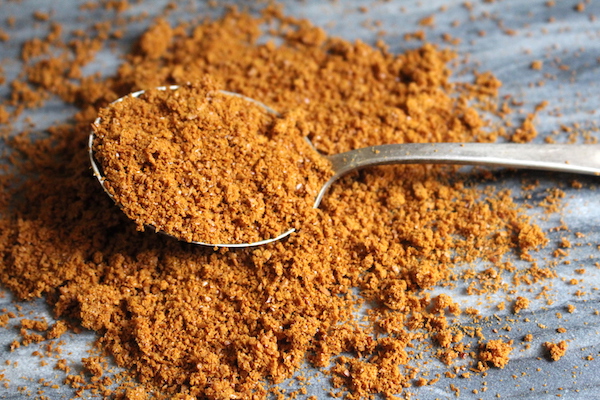
A single backyard apple tree can yield more than 800 pounds of apples in a good year. That’s a lot of apples for one family to consume, and you’re going to have to either give some away or get creative.
Our land has dozens of apple trees, and though they’re not at peak productivity we still have a lot of homegrown apples. That, in turn, means every year we really have to really work to put them all to good use. We start with the old standbys:
- Canning Applesauce
- Canning Apple Cider
- Apple Cider Vinegar
- Hard Cider
- Root Cellaring Apples (Only the good winter storage apple varieties)
Even after you’ve pressed the apples into cider there are still more uses for the pulp. We make apple scrap vinegar from the peels and pomace, beyond just feeding it to the pigs.
My friend Susan at Learning and Yearning makes an apple sugar-like substance by drying the leftover apple pomace after making apple cider. It still has a good bit of sweetness and flavor, and it’s a good way to use up apple pulp, but it’s more dried apple pulp than actual sugar.
Wonderful for adding a bit to oatmeal, but not exactly a baking sugar substitute. Her apple sugar from apple pomace idea got me inspired though.
What if we could make our own granular apple sugar from homegrown apples?
We already make apple cider syrup, which is a pretty good apple sweetener, but granular apple sugar would be pretty spectacular. Boiled cider or cider syrup is concentrated apple cider with nothing else added. It’s shelf-stable, like maple syrup and you can use it in place of maple syrup in cooking or on pancakes.
Making boiled cider syrup is simple, just start with fresh cider and cook it down until it’s 1/7th its original volume. Marking a chopstick and measuring the depth in a pan is helpful for this, or you can watch the bubbles. They’ll change once it gets close to done, and if you’ve made maple syrup before you know what this looks like.
Cider syrup is really delicious, and in a sense, it is extracting sugar from apples for table use. You can use it in any recipe that includes honey or maple, and it adds a sweet-tart flavor of concentrated apple. I was hoping for granular apple sugar though, and my hope is to turn boiled cider syrup into granular sugar.
My kids love boiled cider so much that they finish off our supply early in the winter, so I actually bought a bottle of Boiled Cider Syrup for this experiment. On the one hand, that’s good because it means you can recreate it easily at home. Our local grocery stores carry it since it’s a local Vermont product, but it’s also available online.
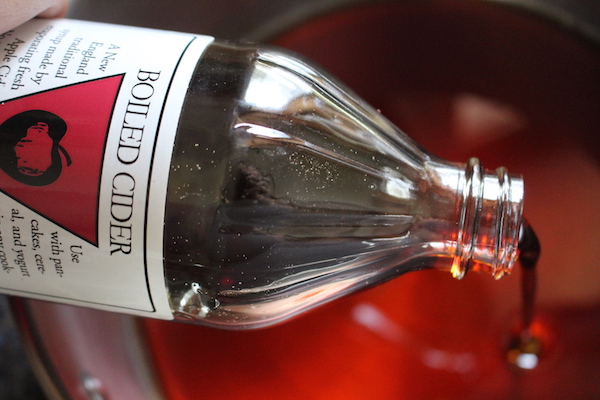
My hope was to cook the cider syrup until it crystalizes like maple sugar. Homemade maple sugar is just maple syrup that’s cooked to roughly 255 to 260 degrees and then stirred rapidly to induce crystallization.
It’s pretty magic watching it happen. Just start stirring the hot syrup and it’ll lighten quickly, and you’ll have powdery maple sugar in about 5 minutes (or 2 minutes if you use a stand mixer.)
In this bit of kitchen science, I wanted to see if that same process would work to turn cider syrup into crystalized apple sugar. It’s a long shot, but it’d be pretty magical if it worked. I started by heating a pint of boiled cider to the same temperature you’d use to make maple sugar.
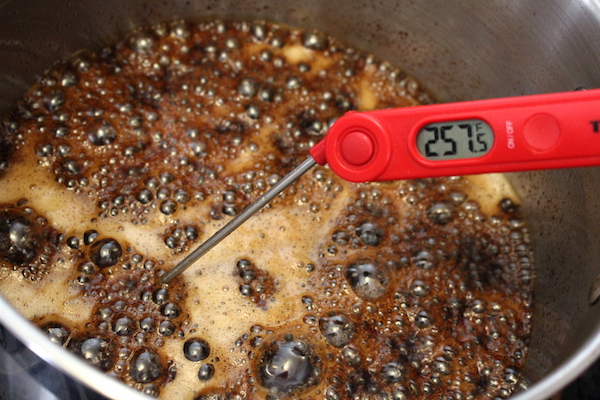
Once the cider syrup was up to temperature, I poured it off into my stand mixer and started the sugar paddling process. Two minutes later it was definitely not granular but it was thickening up.
I was hopeful that maybe it just needed a bit more time. I also happen to have a 2-year-old that’s obsessed with the stand mixer, and he’ll beg to be held so he can watch with wonder as the paddle spins round and round in the bowl. This time, I gave him just what he wanted, and held him for a full 20 minutes watching that paddle go around in the mixer bowl.
Still no luck. The cider syrup wasn’t turning granular, but it had cooled into a pretty spectacular one ingredient apple taffy. Whipping it as it cooled meant that it didn’t form hard candy as it would have left to cool sitting in the pan. Instead, it formed a soft taffy-like apple cider caramel.
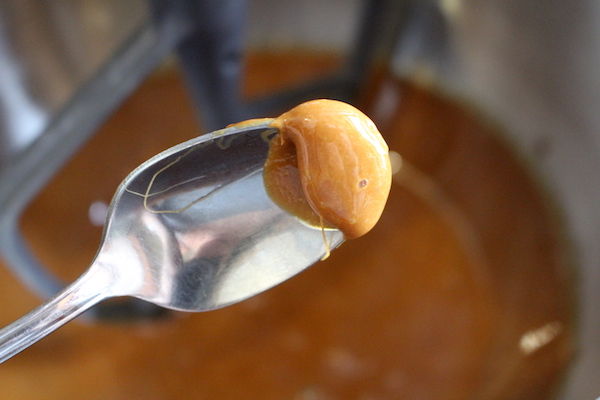
I pulled a bit out and kneaded it, and stretched it hoping to make some kind of apple taffy. Every time it just returned to its original shape, a tasty blob of chewy apple putty. We ate a bit, and it’s truly delicious, and if this is the only good that comes of this experiment I’m still excited because homemade apple caramels without cream or any other ingredients is still pretty magical.
Nonetheless, the science continues to the next step trying to make apple sugar…
I put the apple caramel back into the pan and turned back on the heat. Not wanting to give up prematurely, I started thinking that maybe cider syrup needs to be heated more than maple syrup to induce granulation. I heated it until the first wisp of smoke came off the pan, knowing that’s as hot as it could get without actually burning.
That happened to be right around 310 to 315 degrees F. In candy making, that’s just past “hard crack” stage and it’s where you’d heat table sugar to make toffee. I put it back into the mixer and started the paddle going again…
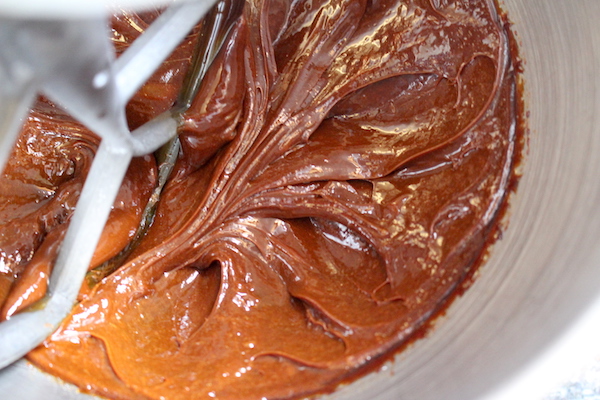
The hard crack stage didn’t yield granular apple sugar either. Predictably, it did yield toffee though. After a lot of whipping hoping it’d turn granular, I poured the toffee batter onto a tray and cut it into some hard candies.
They were again, delicious, and a sweet success in themselves. No corn syrup and nothing else added, just apple cider cooked into a hard candy.
I wrapped a few of them up to savor as candy, but I was still hoping to make this work with the rest of the apple sugar batter…
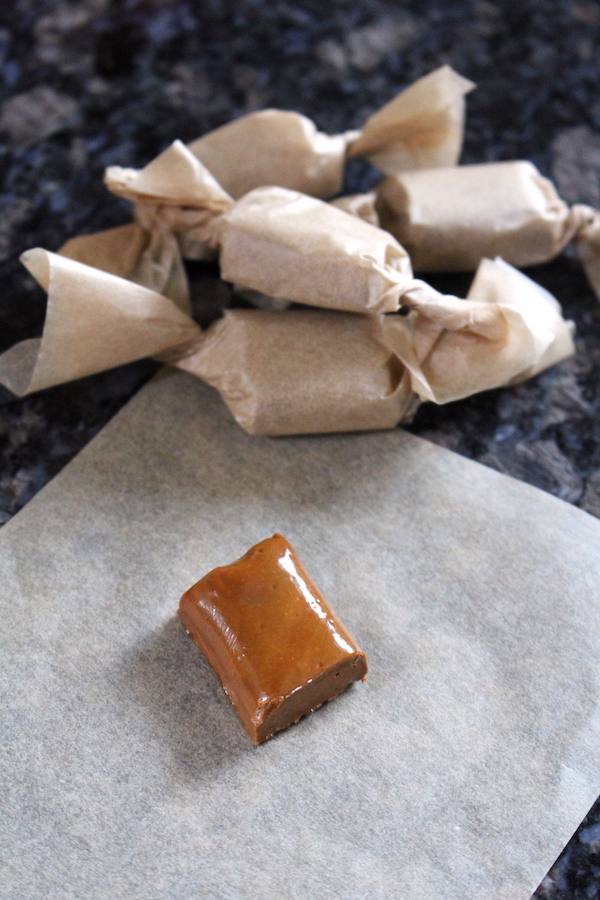
So hard candy is sugar in some ways, and it isn’t in others. What if it’s possible to cook apple cider into hard candy bricks, that you then just crush up when you need sugar?
I took most of the cider hard candies and put them in my mortar and pestle and started crushing. Toffee is pretty brittle, so it crushed up easy enough.
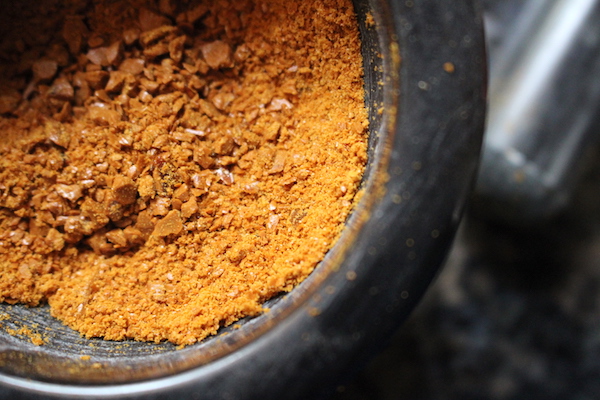
At this point, I was pretty happy. I had a granular sugar-like product made simply from apple cider. I spread it out on the counter, took some fancy pictures and smiled smugly to myself. Not what I was hoping for, it didn’t just whip up like maple sugar granules, but this was workable, right?
That’s until I tried cooking with it…
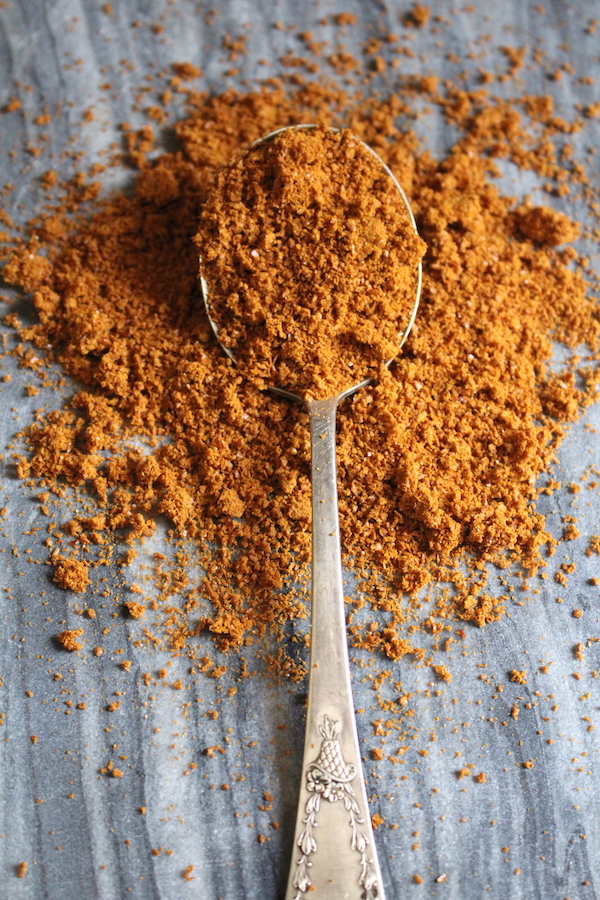
Pretty though it may be, it doesn’t cook well. I tried something basic, a batch of 3 ingredients shortbread with just flour, butter, and my homemade “apple sugar.” It was terrible. Actually so bad it was completely inedible. For starters, this “apple sugar” is much less sweet than the same volume of cane sugar. Second, it’s got a good bit of acidity from the apples, so it actually tastes more tart than sweet. And finally, since it’s already cooked pretty well to the smoke point, baking it meant that the sugar crystals just created little black burned spots in the cookies.
Apple sugar fail!
Crushed up hard candies are made of sugar, but they are not in fact sugar. It wasn’t a total loss though. Even after all that cooking, I was able to take a spoonful of crushed apple hard candy sugar and add it to a cup of boiling water to make a reconstituted apple cider.
It wasn’t quite the same as fresh because it tasted a bit carmelized with all that cooking. Not a bad thing though, and caramel apple cider from a homemade powder is pretty good too.
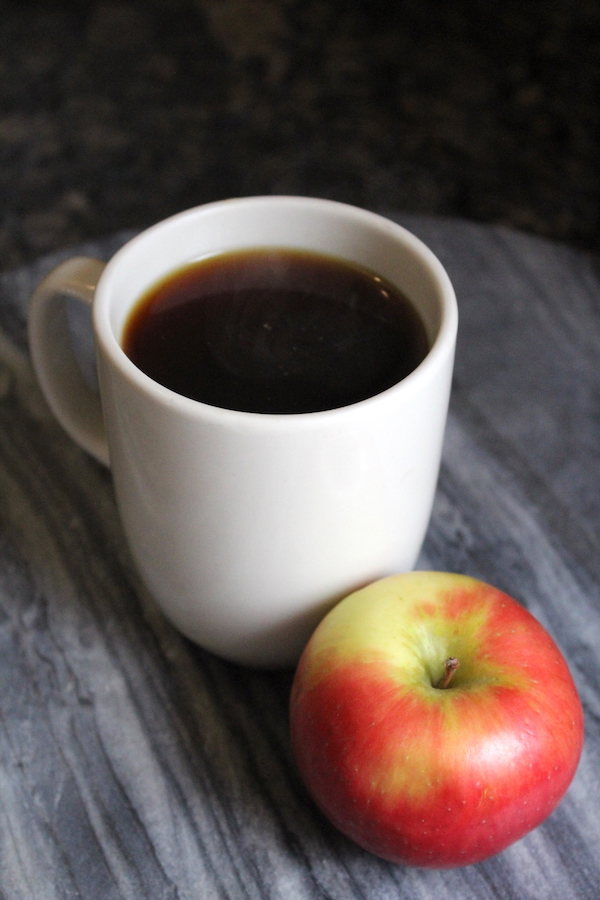
This experiment did have some good lessons, primarily that cider syrup cooked to 255 to 260 degrees and then whipped makes spectacular soft caramels. It does not make an apple-based baking sugar though.
I still have a few more ideas to try. On the one hand, apple sugar is fructose, which probably explains why it doesn’t behave the same way as maple sugar when whipped. That may explain why corn syrup is commonly sold as a syrup rather than as a granular sugar.
The thing is, you can make corn sugar, a granular fructose sugar and we use it to prime bottles for homebrewed beer. I’ve yet to find a source that explains how that’s made, and I fear that maybe it involves too much chemistry for the casual home kitchen.
For now, we’re sticking with using apple cider syrup as our apple sugar source here on the homestead. It is a homemade sugar from apples, it’s just not granular. It’s easy, it tastes great and it’s shelf-stable. Asking for granular too is just asking too much!
More Homestead Kitchen Science
Looking for more kitchen science experiments? Here are a few fun ones to try:
- How to Render Squirrel Fat (for cookies!)
- How to Make Donuts After the Apocalypse
- How to Use Butter Powder
- How to Cook Hostas
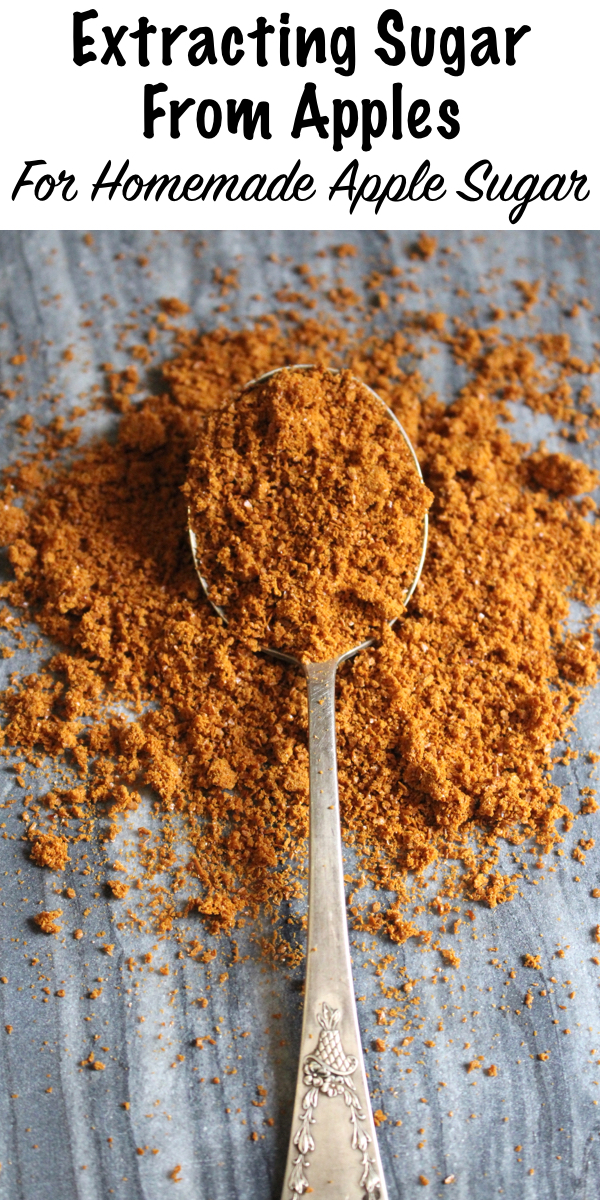

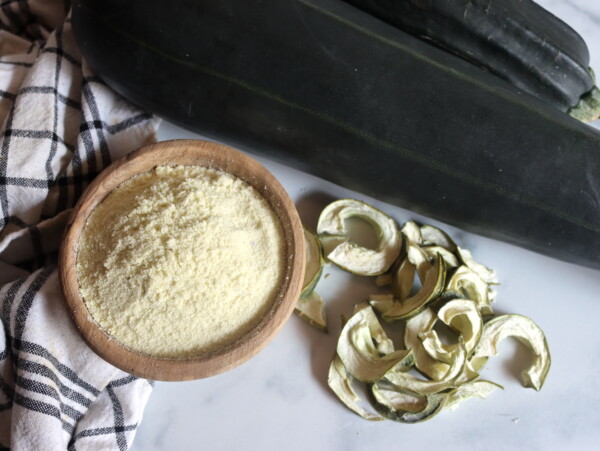












Cool information. Will definately try some of this.
Have you thought about taking apple juice and dehydrating it?
I’ve heard people doing that and I’m honestly not sure if it’d make more like a fruit leather than a sugar. We cook down cider to make cider syrup and it’s really good, but I think just dehydrating cider you’d get something like a sticky apple butter or leather? I don’t know, I haven’t tried it.
Wow! This was such a good read. Normally I hate reading blogs. They always feel so drug out and I’m always like just get to the point but yours kept me captivated the whole time! And seeing your links to other ideas only made me want to follow you more! I’m so excited to continue following your journey, and playing catch up. You are what I aspire to in my homestead 💚💚💚 thank you so much for sharing with us!
That’s so sweet of you. We’re so glad you enjoyed the post.
Very cool! I ws curious how to turn fruit into sugar and this was very informitive. I wonder, after boiling it down, if you could do the kids sugar crytal making approach where you hang a string in the liquid and wait for sugar crystals to grow?
That’s a good question. I’m not sure how that would work but if you decide to do an experiment let us know how it works.
You are my new hero(ine.) My sister and I are planning on pressing cider next year – we finally had a surfeit of apples this season beyond what we could eat, dry, give away or turn into pies. I sent your article to her and she is very excited to try it! Thanks so much for letting us see the results of your experience!
You’re so welcome. We’re glad you enjoyed the post.
I really appreciate your adventure in trying to create apple sugar. I am curious if you could freeze dry it and then grind it up? I don’t have a freeze dryer but it makes me wonder. I’ve been looking for molasses recipes that, if I can’t get my hands on sugar, I could use to sweeten baked goods. I think apple cider syrup could be used like a molasses. I have made it once and used it in making an apple granola which turned out quite tasty. Thanks!
I think that’s actually a great idea. I would be interested to hear how it works if you give it a try.
For corn syrup, it looks like it is simple acid hydrolysis of corn starch in a pressure cooker. An instapot would probably work.It is glucose though and sold as brands like Karo. . To make it high fructose you have to add enzymes to do the conversion of glucose to fructose, and buying the enzymes like glucose isomerase in small quantities may be cost prohibitive and for beer making I am not sure it is necessary.
http://www.madehow.com/Volume-4/Corn-Syrup.html
The problem is you are cooking fructose and expecting it to behave like sucrose. Table Sucrose is 50% fructose and 50% glucose.
I was wondering if apple cider could be made into sugar. Thanks for answering that. I do like the idea of apple taffy or apple caramel. Perhaps it didn’t work out because of the natural pectin that might be present in small amounts in apple cider. Maybe you can try clearing the cider with pectin enzyme that brewers use for hard cider-making.
That was amazing! Thank you so much for sharing! It was exactly what I was looking for! I was asking myself if you can make sugar out of apples and you answered my question exactly!! 😆😆
You’re very welcome. I’m so glad you enjoyed the post.
Typed on phone pls forgive typos and shortened grammar.
You may be able to place a string into the apple sirrup and have sugar crystals form on them that can be crushed. I believe that is how sugar was extracted from sugar beets before chemical cleaning of sugar was done.
The chemical process to extract or clean glucose adds then removes other chemicals … Ie baking soda may reacte with the cytrix acid and form a solid that can be filtered out with say a coffee filter I believe commercialy they use lie followed by a co2 bath which reactes with the lie but is not water soluble.
But is you clean it to pure glucose it would be no different than table sugar. Maybe sugar crystals would keep some of the appleness.
Sounds like you went in the direction of increased heat (212-257-315) when the project calls for removing water. I think the temperature is less critical than keeping the batch warm enough to keep driving off moisture. High heat changes the sugar. The objective is evaporation. Once the batch is boiled down to 1/7, spread it in a pan, keep it warm in the oven on its lowest setting to evaporate more water. It should become a fruit leather. Slice that into smaller pieces, stick in a food dehydrator. That’ll give it 130-150 degrees and turn the stuff into stiff noodles. Pulverize the noodles, put em through a grain mill, end up with powdered cider. The sugar was never separated from the cider. The result will not be sugar crystals, but it also wont be toffee. I bet it would work better in those cookies.
That’s a really great idea!
Thank you for this suggestion! I found this article while trying to discover whether reducing cider to a powder was possible, not for using it as sugar, but for reconstituting back into cider later – my end goal is to make a dehydrated powder version of my family’s wassail recipe for holiday gifts. I will attempt this with your proposed alterations using a dehydrator.
FANTASTIC article. I sent it to my wife as soon as I saw it.
Can you do a review on cider presses at some point?
Thanks so much! I have a kinda/sorta review on the two types of cider presses I’ve used here: https://practicalselfreliance.com/using-double-barrel-cider-press/
Wow! Fascinating – thanks for sharing!
Have you ever heard of Kenji Alt Lopez before? He has this incredible website (and book) called “The Food Lab” where he digs deeper into the science of food. In fact, your writing and approach to cooking reminds me a lot of his.